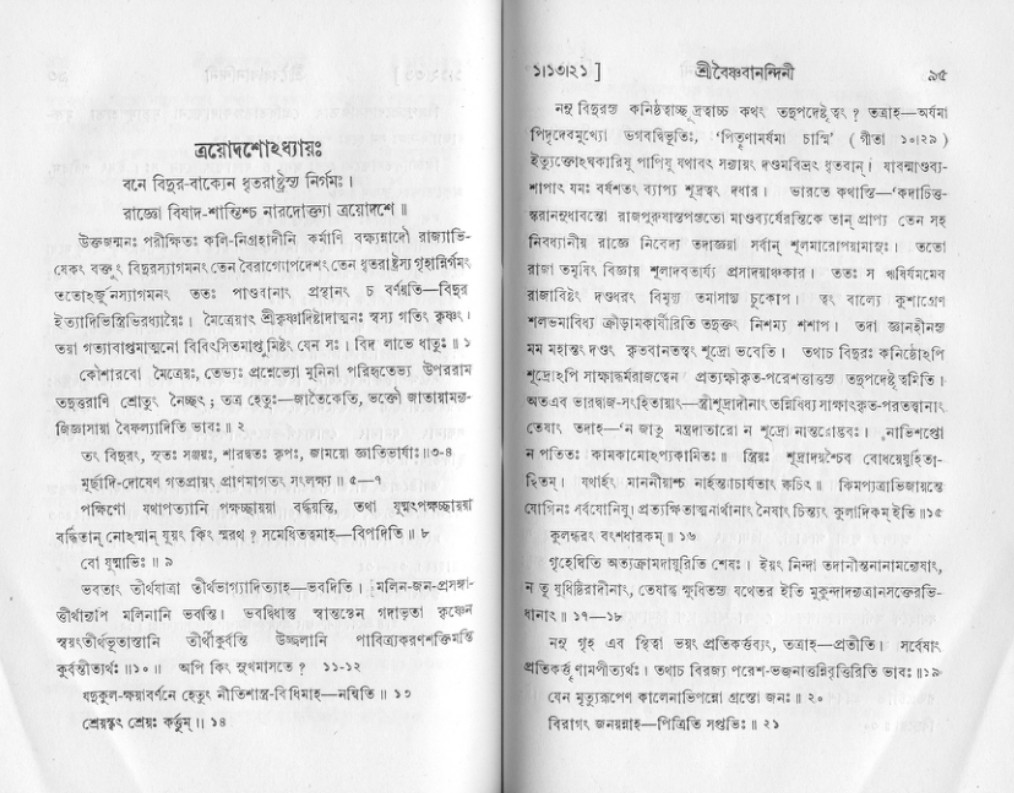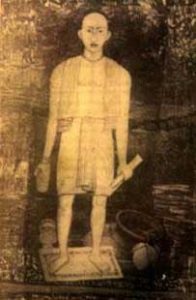The following is a transliteration and English translation of Śrī Baladeva Vidyābhūṣaṇa’s Vaiṣṇavānandinī commentary on Śrīmad-Bhāgavatam 1.13.15. In the commentary, Mahābhārata (including Bhagavad-gītā) and Bhāradvāja-saṁhitā are quoted. The source is from Haridāsa Bābā’s Bengali transliteration of Vaiṣṇavānandinī
Source: https://archive.org/details/Vaisnavanandini.HaridasBaba
nanu vidurasya kaniṣṭhatvāc chūdratvāc ca kathaṁ tad-upadeṣṭṛtvaṁ? tatrāha: aryamā pitṛ-deva-mukhyo bhagavad-vibhūtiḥ, “pitṝṇām aryamā cāsmi” ity ukto ‘ghakāriṣu pāpiṣu yathāvat sanyāyaṁ daṇḍam abibhrat dhṛtavān. yāvan māṇḍavya-śāpāt yamaḥ varṣa-śataṁ vyāpya śūdratvaṁ dadhāra. bhārate kathāsti: kadācit taskarān anudhāvanto rāja-puruṣās tapasyato māṇḍavya-rṣer antike tān prāpya tena saha nibadhyānīya rājñe nivedya tad-ājñayā sarvān śūlam āropayām āsuḥ. tato rājā tam ṛṣiṁ vijñāya śūlād avatārya prasādayāṁ cakāra. tataḥ sa ṛṣir yamam eva rājāviṣṭaṁ daṇḍadharaṁ vimṛṣya tam āsādya cukopa. “tvaṁ bālye kuśāgreṇa śalabham āvidhya krīḍām akārṣīr” iti tad-uktaṁ niśamya śaśāpa. tadā jñāna-hīnasya mama mahāntaṁ daṇḍaṁ kṛtavān. atas tvaṁ śūdro bhaveti. tathā ca viduraḥ kaniṣṭho ‘pi. śūdro ‘pi sākṣād-dharma-rājatvena pratyakṣī-kṛta-pareśāt tasya tad-upadeṣṭṛtvam iti. ata eva bhāradvāja-saṁhitāyāṁ strī-śūdrādīnāṁ tan niṣidhya sākṣātkṛta-para-tattvānāṁ teṣāṁ tad āha: “na jātu mantra-dātāro na śūdro nāntarodbhavaḥ, nābhiśapto na patitaḥ kāma-kāmo ‘py akāmitaḥ; striyaḥ śūdrādayaś caiva bodhayeyur hitāhitam, yathārhaṁ mānanīyāś ca nārhanty ācāryatāṁ kvacit; kim apy atrābhijāyante yoginaḥ sarva-yoniṣu; pratyakṣitātma-nāthānāṁ naiṣāṁ cintyaṁ kulādikam” iti.
Objection: How can Vidura instruct Dhṛtarāṣṭra since Vidura was younger to him and a śūdra?
Response: Aryamā is the chief of pitṛ-devas and is one of the vibhutis (opulences) of the Lord. He has been described [in Bhagavad-gītā 10.29] as “Of departed ancestors, I am Aryamā.”
As long as [Vidura] played the part of a śūdra for a hundred years, being cursed by Māṇḍavya Muni, [Aryamā] administered suitable punishment unto persons who had committed sins.
[The following] history is in the Mahābhārata.
Once upon a time, government officials chased [some] thieves and found them near Māṇḍavya Ṛṣi who was engaged in austerities. They arrested them along with him and presented them to the king. On his order, they had all of them impaled. When the king then realized that a ṛṣi [was among them], he had him taken off the stake and begged for his favor. The sage then considered that it was actually Yamarāja who had administered this punishment through the king. He went to Yamarāja and expressed his anger. [Yama said], “In your childhood, you pierced an insect with the tip of a kuśa grass and enjoyed it!” Upon hearing this, the sage cursed [Yamarāja], “I was ignorant at that time. You have excessively punished me. So become a śūdra!”
And so, though Vidura was younger [to Dhṛtarāṣṭra and] though he was a śūdra [by birth], because he was Dharmarāja himself, he had directly realized the Supreme Lord; therefore, he instructed Dhṛtarāṣṭra.
It is for this reason that the Bhāradvāja-saṁhitā forbids women, śūdras and the like [from becoming gurus] and allows women, śūdras and the like who have directly realized the Supreme Truth [to become gurus]:
“Even then, a woman, a śūdra and an antyaja can never act as initiating gurus, nor can anyone who is accused of a great sin or is fallen. And an aspiring disciple who is already accomplished in detachment (akāmī) should never accept a guru who is infected with material desires.” (1.42)
“Women, śūdras, etc., can give ethical and moral instructions and are also worthy of respect as per their qualifications and conditions but are not entitled to get the position of ācārya.” (1.43)
“But, because perfect yogis who are on the stage of yoga-pratyakṣa (i.e. are self-realized – seeing God face-to-face), pratyakṣitātma-nāthānām, may take birth in any family tradition, in such cases no consideration of kula, gender, etc. as mentioned earlier apply (they can become ācāryas).” (1.44)
Page 51 of the publication is reproduced below:


